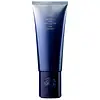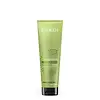What's inside
What's inside
 Key Ingredients
Key Ingredients

No key ingredients
 Benefits
Benefits

 Concerns
Concerns

 Ingredients Side-by-side
Ingredients Side-by-side

Water
Skin ConditioningCyclopentasiloxane
EmollientIsododecane
EmollientDimethicone
EmollientHydrogenated Polydecene
EmollientButylene Glycol
HumectantPhenyl Trimethicone
Skin ConditioningDimethiconol
EmollientAcrylamide/Sodium Acryloyldimethyltaurate Copolymer
Emulsion StabilisingIsohexadecane
EmollientParfum
MaskingOleth-10
EmulsifyingCyclohexasiloxane
EmollientBenzyl Alcohol
PerfumingChlorphenesin
AntimicrobialPolysorbate 80
EmulsifyingPanthenol
Skin ConditioningTetrasodium EDTA
Sorbic Acid
PreservativeSorbitan Oleate
EmulsifyingGlycerin
HumectantBis-Behenyl/Isostearyl/Phytosteryl Dimer Dilinoleyl Dimer Dilinoleate
EmollientBenzophenone-4
UV AbsorberHelianthus Annuus Seed Extract
Skin ConditioningPPG-3 Benzyl Ether Myristate
EmollientCinnamidopropyltrimonium Chloride
Styrax Benzoin Resin Extract
MaskingWheat Amino Acids
Skin ConditioningHydrolyzed Jojoba Protein
Skin ConditioningHydrolyzed Rice Protein
Skin ConditioningHydrolyzed Soy Protein
HumectantCystine Bis-Pg-Propyl Silanetriol
Skin ConditioningHydrolyzed Vegetable Protein Pg-Propyl Silanetriol
Skin ConditioningHydrolyzed Vegetable Protein
Skin ConditioningPhenoxyethanol
PreservativeKaempferia Galanga Root Extract
Skin ConditioningLeontopodium Alpinum Extract
Skin ConditioningPotassium Sorbate
PreservativeCitrullus Lanatus Fruit Extract
Skin ConditioningSodium Benzoate
MaskingCitric Acid
BufferingPotassium Benzoate
PreservativeCitrulline
Skin ConditioningDisodium EDTA
Ethylhexylglycerin
Skin ConditioningLitchi Chinensis Pericarp Extract
Skin ConditioningMoringa Oleifera Seed Extract
Skin ConditioningDisodium Phosphate
BufferingPentaerythrityl Tetra-Di-T-Butyl Hydroxyhydrocinnamate
AntioxidantBenzyl Benzoate
AntimicrobialLimonene
PerfumingLinalool
PerfumingHexyl Cinnamal
PerfumingCitral
PerfumingMica
Cosmetic ColorantCI 77891
Cosmetic ColorantWater, Cyclopentasiloxane, Isododecane, Dimethicone, Hydrogenated Polydecene, Butylene Glycol, Phenyl Trimethicone, Dimethiconol, Acrylamide/Sodium Acryloyldimethyltaurate Copolymer, Isohexadecane, Parfum, Oleth-10, Cyclohexasiloxane, Benzyl Alcohol, Chlorphenesin, Polysorbate 80, Panthenol, Tetrasodium EDTA, Sorbic Acid, Sorbitan Oleate, Glycerin, Bis-Behenyl/Isostearyl/Phytosteryl Dimer Dilinoleyl Dimer Dilinoleate, Benzophenone-4, Helianthus Annuus Seed Extract, PPG-3 Benzyl Ether Myristate, Cinnamidopropyltrimonium Chloride, Styrax Benzoin Resin Extract, Wheat Amino Acids, Hydrolyzed Jojoba Protein, Hydrolyzed Rice Protein, Hydrolyzed Soy Protein, Cystine Bis-Pg-Propyl Silanetriol, Hydrolyzed Vegetable Protein Pg-Propyl Silanetriol, Hydrolyzed Vegetable Protein, Phenoxyethanol, Kaempferia Galanga Root Extract, Leontopodium Alpinum Extract, Potassium Sorbate, Citrullus Lanatus Fruit Extract, Sodium Benzoate, Citric Acid, Potassium Benzoate, Citrulline, Disodium EDTA, Ethylhexylglycerin, Litchi Chinensis Pericarp Extract, Moringa Oleifera Seed Extract, Disodium Phosphate, Pentaerythrityl Tetra-Di-T-Butyl Hydroxyhydrocinnamate, Benzyl Benzoate, Limonene, Linalool, Hexyl Cinnamal, Citral, Mica, CI 77891
Water
Skin ConditioningCetearyl Alcohol
EmollientCetyl Esters
EmollientAmodimethicone
Behentrimonium Chloride
PreservativePhenoxyethanol
PreservativeParfum
MaskingSorbitol
HumectantIsopropyl Alcohol
SolventTrideceth-6
EmulsifyingHydrolyzed Soy Protein
HumectantMoringa Oleifera Seed Oil
EmollientHydrolyzed Vegetable Protein Pg-Propyl Silanetriol
Skin ConditioningArginine
MaskingCitric Acid
BufferingCetrimonium Chloride
AntimicrobialChlorhexidine Dihydrochloride
AntimicrobialHexyl Cinnamal
PerfumingLinalool
PerfumingEthylhexyl Methoxycinnamate
UV AbsorberLimonene
PerfumingCoumarin
PerfumingBenzyl Alcohol
PerfumingWater, Cetearyl Alcohol, Cetyl Esters, Amodimethicone, Behentrimonium Chloride, Phenoxyethanol, Parfum, Sorbitol, Isopropyl Alcohol, Trideceth-6, Hydrolyzed Soy Protein, Moringa Oleifera Seed Oil, Hydrolyzed Vegetable Protein Pg-Propyl Silanetriol, Arginine, Citric Acid, Cetrimonium Chloride, Chlorhexidine Dihydrochloride, Hexyl Cinnamal, Linalool, Ethylhexyl Methoxycinnamate, Limonene, Coumarin, Benzyl Alcohol
Ingredients Explained
These ingredients are found in both products.
Ingredients higher up in an ingredient list are typically present in a larger amount.
Benzyl Alcohol is most commonly used as a preservative. It also has a subtle, sweet smell. Small amounts of Benzyl Alcohol is not irritating and safe to use in skincare products. Most Benzyl Alcohol is derived from fruits such as apricots.
Benzyl Alcohol has both antibacterial and antioxidant properties. These properties help lengthen the shelf life of products. Benzyl Alcohol is a solvent and helps dissolve other ingredients. It can also improve the texture and spreadability.
Alcohol comes in many different forms. Different types of alcohol will have different effects on skin. This ingredient is an astringent alcohol.
Using high concentrations of these alcohols are drying on the skin. They may strip away your skin's natural oils and even damage your skin barrier. Astringent alcohols may also irritate skin.
Other types of astringent alcohols include:
According to the National Rosacea Society based in the US, you should be mindful of products with these alcohols in the top half of ingredients.
Any type of sanitizing product will have high amounts of alcohol to help kill bacteria and viruses.
Learn more about Benzyl AlcoholCitric Acid is an alpha hydroxy acid (AHA) naturally found in citrus fruits like oranges, lemons, and limes.
Like other AHAs, citric acid can exfoliate skin by breaking down the bonds that hold dead skin cells together. This helps reveal smoother and brighter skin underneath.
However, this exfoliating effect only happens at high concentrations (20%) which can be hard to find in cosmetic products.
Due to this, citric acid is usually included in small amounts as a pH adjuster. This helps keep products slightly more acidic and compatible with skin's natural pH.
In skincare formulas, citric acid can:
While it can provide some skin benefits, research shows lactic acid and glycolic acid are generally more effective and less irritating exfoliants.
Most citric acid used in skincare today is made by fermenting sugars (usually from molasses). This synthetic version is identical to the natural citrus form but easier to stabilize and use in formulations.
Read more about some other popular AHA's here:
Learn more about Citric AcidHexyl Cinnamal is a fragrance ingredient with a similar scent to jasmine. It can be naturally found in chamomile essential oil.
This ingredient is a known EU allergen and may sensitize the skin. The EU requires this ingredient to be listed separately on an ingredients list.
Hexyl Cinnamal is not water soluble but is soluble in oils.
Learn more about Hexyl CinnamalHydrolyzed Soy Protein is a vegan protein made to mimic hydrolyzed collagen. It is created from soy, or glycine soja.
This ingredient is a humectant, meaning it helps hydrate the skin by binding to water. According to a manufacturer, it is also a great hair conditioner.
Read more about hydrolyzed collagen here.
Learn more about Hydrolyzed Soy ProteinWe don't have a description for Hydrolyzed Vegetable Protein Pg-Propyl Silanetriol yet.
Limonene is a fragrance that adds scent and taste to a formulation.
It's found in the peel oil of citrus fruits and other plants such as lavender and eucalyptus. The scent of limonene is generally described as "sweet citrus".
Limonene acts as an antioxidant, meaning it helps neutralize free radicals.
When exposed to air, oxidized limonene may sensitize the skin. Because of this, limonene is often avoided by people with sensitive skin.
The term 'fragrance' is not regulated in many countries. In many cases, it is up to the brand to define this term. For instance, many brands choose to label themselves as "fragrance-free" because they are not using synthetic fragrances. However, their products may still contain ingredients such as essential oils that are considered a fragrance.
Learn more about LimoneneLinalool is a fragrance and helps add scent to products. It's derived from common plants such as cinnamon, mint, citrus, and lavender.
Like Limonene, this ingredient oxidizes when exposed to air. Oxidized linalool can cause allergies and skin sensitivity.
This ingredient has a scent that is floral, spicy tropical, and citrus-like.
Learn more about LinaloolParfum is a catch-all term for an ingredient or more that is used to give a scent to products.
Also called "fragrance", this ingredient can be a blend of hundreds of chemicals or plant oils. This means every product with "fragrance" or "parfum" in the ingredients list is a different mixture.
For instance, Habanolide is a proprietary trade name for a specific aroma chemical. When used as a fragrance ingredient in cosmetics, most aroma chemicals fall under the broad labeling category of “FRAGRANCE” or “PARFUM” according to EU and US regulations.
The term 'parfum' or 'fragrance' is not regulated in many countries. In many cases, it is up to the brand to define this term.
For instance, many brands choose to label themselves as "fragrance-free" because they are not using synthetic fragrances. However, their products may still contain ingredients such as essential oils that are considered a fragrance by INCI standards.
One example is Calendula flower extract. Calendula is an essential oil that still imparts a scent or 'fragrance'.
Depending on the blend, the ingredients in the mixture can cause allergies and sensitivities on the skin. Some ingredients that are known EU allergens include linalool and citronellol.
Parfum can also be used to mask or cover an unpleasant scent.
The bottom line is: not all fragrances/parfum/ingredients are created equally. If you are worried about fragrances, we recommend taking a closer look at an ingredient. And of course, we always recommend speaking with a professional.
Learn more about ParfumPhenoxyethanol is a preservative that has germicide, antimicrobial, and aromatic properties. Studies show that phenoxyethanol can prevent microbial growth. By itself, it has a scent that is similar to that of a rose.
It's often used in formulations along with Caprylyl Glycol to preserve the shelf life of products.
Water. It's the most common cosmetic ingredient of all. You'll usually see it at the top of ingredient lists, meaning that it makes up the largest part of the product.
So why is it so popular? Water most often acts as a solvent - this means that it helps dissolve other ingredients into the formulation.
You'll also recognize water as that liquid we all need to stay alive. If you see this, drink a glass of water. Stay hydrated!
Learn more about Water